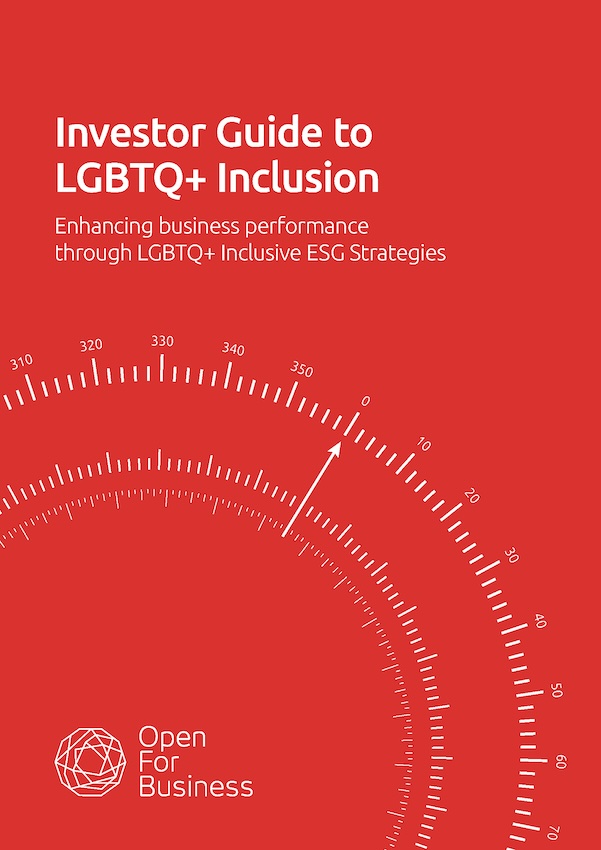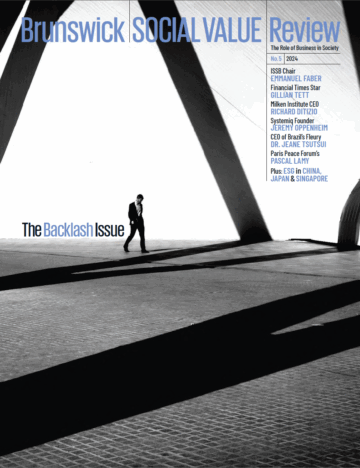An Open For Business coalition study finds connections between transparent reporting and profits for investors.
Corporate support for LGBTQ+ inclusion has been having a rough time lately—dismissed as a political agenda, a woke ideology. Many see it as a distraction from the fiduciary obligation to investors, or worse, as an unnecessary drain on the company’s resources.
Yet research published this year by the Open For Business (OFB) coalition shows the opposite: LGBTQ+ inclusion is linked to greater profitability. The report, the organization’s first Investor Guide to LGBTQ+ Inclusion, finds that transparent reporting on inclusion—still sorely lacking in many businesses even despite their stated intentions—is associated with stronger business performance.
The Open For Business coalition was launched in 2015 at the Clinton Global Initiative Annual Summit as a response to the growing global backlash against LGBTQ+ rights. The coalition now has 37 major businesses as partners, including Accenture, Brunswick, GSK, IKEA, Google, Microsoft, Virgin and Unilever. Since then, the coalition has worked around the world to advance the economic and business case for LGBTQ+ rights.
“This is important research that backs up what Open For Business has been saying all along,” says Jon Miller, Open For Business founder, co-author of the report and co-editor of this magazine. “LGBTQ+ inclusion is a hallmark of a well-run business—and investors are increasingly aware of this.”
The Investor Guide analyzes the recent results of 290 of the world’s largest listed companies across four countries: the US, UK, Australia and Germany. The researchers ranked the degree of LGBTQ+ transparency at each of those companies on a 13-point scale based on each company’s reporting, and mapped that ranking onto the results.
The study found that the 25 companies with the highest LGBTQ+ transparency scores also have the higher profit margins out of the group. Average profit, as a percentage of revenue, is 2.3 times greater at those companies than at the 25 businesses scoring lowest on the transparency scale.
“This data confirms what many business leaders intuitively grasp,” Miller says. “LGBTQ+ inclusion is about running a productive, innovative workplace and engaging a new generation of consumers. This makes for a resilient business—which is what investors care about.”

Stronger commercial performance from LGBTQ+ transparency appears in company reporting in four discrete areas:
Financial Performance: In addition to being 2.3 times more profitable than those with low LGBTQ+ transparency scores, the top 25 companies also had better share price performance, higher market valuations and stronger cash flows.
Reputation and Brand: LGBTQ+ transparency increases the chances for both corporate reputation and brand preference. Fourteen of the companies in the top 25 list were featured in Fortune’s list of the World’s Most Admired Companies.
Access to LGBTQ+ Consumer Spending: Global LGBTQ+ consumer spending eclipses the GDP of leading economies such as Japan, Germany, India and France. LGBTQ+ transparency increases brand recognition for companies with strong LGBTQ+ policies and thus drives spending in their direction.
Greater Internal Diversity: Creating LGBTQ+-inclusive work environments can help attract the best talent, sending a strong signal that a business is fair and meritocratic. More transparent companies have an LGBTQ+ workforce 1.5 times larger compared to those less transparent.
Perhaps more striking, given the ongoing backlash against ESG generally in the US, 92% of companies surveyed listed DEI as a material issue in their assessments for investors. This means companies believe poor performance on DEI could threaten the long-term viability of the business.
Three social concerns for the LGBTQ+ community were mentioned the most by companies in their materiality assessments:
Human Rights: Sixty-six countries still criminalize LGBTQ+ people, including 12 which impose the death penalty for consensual same-sex activity. In addition, for those reasons or because of other national crises, many LGBTQ+ people become refugees, where they are faced with new uncertainties and, often, the risk of further persecution in their new locations.
Access to Finance: LGBTQ+ people are less able to find appropriate financial support, including loans, banking services and credit. Many LGBTQ+ people also face higher rates of homelessness, poverty and pay discrimination. They are also more likely to be uninsured.
Healthcare: The healthcare challenges include legal and nonlegal discrimination. In the US, 22 states outlaw gender-affirming care, for instance, and a survey in 2022 found that LGBTQ+ patients were more than three times more likely to delay or avoid medical care because of disrespect or discrimination from a healthcare provider.
The report lists ways that companies are finding to support the LGBTQ+ community through these obstacles. On human rights, more than 400 companies have signed the UN Standards of Conduct for Business against LGBTQ+ discrimination. Others have provided pro bono legal services or direct services in collaborations with civil organizations. Airbnb, for instance, partnered with ORAM (Organization for Refugee, Asylum and Migration) to provide 3,000 nights of safe, short-term housing to LGBTQ+ people displaced from Ukraine.
In finance, some banks, including Wells Fargo, have LGBTQ+ resource centers to address the community’s challenges. Others are supporting and mentoring LGBTQ+ entrepreneurs. And in healthcare, actions range from helping transgender customers receive the care they need to sensitivity training for healthcare providers and increasing mental health services for the LGBTQ+ community.
Companies with the highest LGBTQ+ transparency scores are 2.3 times more profitable.
Investor Interest is Increasing
Despite a popular perception in the US that investors are backpedaling on social concerns, the research finds that investment in companies based on their inclusion principles is still strong and poised to grow.
Of US investors, 45% are interested in investment products that advance LGBTQ+ inclusion. This figure is set to increase as younger generations become more of an investment force. Currently, over 60% of wealth in the US is held by individuals over 58. Meanwhile, 56% of Millennials and 67% of Gen Z (aged 18 to 26) investors favor pro-LGBTQ+ equity and inclusion products. This generational shift will also affect assets under management, normalizing expectations that are still regarded negatively by some older investors. A report by Morgan Stanley estimates that as younger generations continue to inherit wealth, the value of US assets under management by those interested in pro-LGBTQ+ products could increase by 42%. In other words, an additional $8.4 trillion of assets will be interested in pro-LGBTQ+ investment opportunities, over the current level of nearly $20 trillion. All of this indicates that investor demand, far from retreating, will increase in coming years.
Of the 13 points OFB measured for its LGBTQ+ transparency scale, five appeared the most frequently in the corporate reporting of top-ranked businesses.
- The existence of an LGBTQ+ employee resource group or network
- The results of an LGBTQ+ workplace equality index or award
- The existence of a supplier diversity program inclusive of LGBTQ+-owned businesses
- LGBTQ+ partnerships with civil society organizations
- LGBTQ+ benefits, for example, same-sex partner medical benefits, gender-affirming care, parental leave for same-sex partners who create a family through adoption or surrogacy.
In the US, 92% of companies surveyed listed DEI as a material issue in their assessments for investors.
Nine Key Questions
Armed with the results of the report, investors looking for LGBTQ+ inclusive companies can be prepared to ask specific questions of the businesses in which they invest. Below is a summary of the report’s suggestions across nine key questions.
1. Are policies and procedures inclusive?
That means making LGBTQ+ rights an explicit part of anti-discrimination policies, healthcare coverage, employee and domestic partner benefits.
2. Is workplace culture managed proactively?
This can be observed in active LGBTQ+ employee network groups, inclusiveness training for all employees, representation in internal communications and role models in leadership positions.
3. Is inclusion managed along the employee life cycle?
This can consist of specific recruitment events for LGBTQ+ applicants, inclusiveness training for all employees and analyzing LGBTQ+ workforce data, including from exit interviews, for shortcomings.
4. Is inclusion incorporated along the value chain?
All aspects of procurement and marketing need to reflect the organization’s dedication to inclusion. This includes ensuring supplier diversity and targeting certified LGBTQ+ suppliers.
5. Is community engagement meaningful?
Businesses can show support for LGBTQ+ civil society organizations through board service, partnership, sponsorship or philanthropy. Significant dates and events in the lives and cultures of the LGBTQ+ community are represented in the company calendar.
6. How is employee data collected and used?
Careful consideration should be given about what data is collected and why, and how it is shared, taking care to ensure the privacy and concerns of the LGBTQ+ community.
7. Is senior leadership engaged?
Role models and allies in top executive and board positions are a vital part of a business’s commitment to LGBTQ+. Inclusion efforts within the business should be clearly accountable to the board and top executives.
8. Is the commitment to inclusive workplaces global?
The same LGBTQ+ policies and practices should be applied everywhere the business operates, even in countries opposed to LGBTQ+ rights.
9. What are the public engagement policies?
Public statements and advocacy to counter potential discrimination in society and to promote inclusion in the workplace are clear indicators of a business’s commitment to LGBTQ+ inclusion.
“LGBTQ+ equality is a human rights issue, yes—and many businesses also look at it as a business issue,” Miller says. “I hope this report gives confidence to companies who are committed to LGBTQ+ inclusion that there is a strong investor case backing them up.”
More from this issue

The Backlash
Most read from this issue

Foreword




